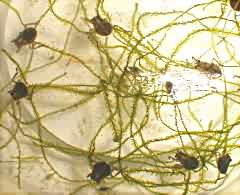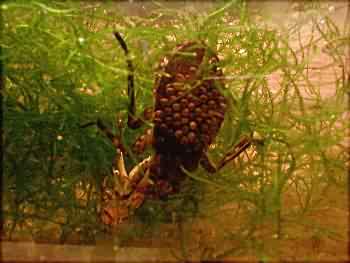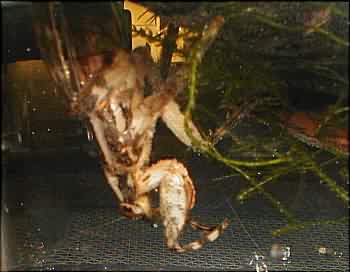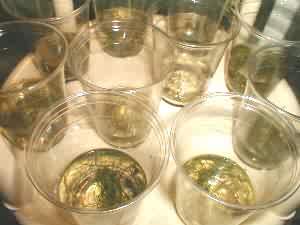


Abedus herberti is among the largest (to nearly two inches; 45mm) in the genus Abedus and is the most easily reared giant water bug. Adults and nymphs are fun to watch as they attack prey. Adults are able to fly but usually don't. A. herberti are able to inflict painful bites but are not vicious and will only bite if grabbed carelessly.
Food: Both adults and nymphs of Abedus herberti will eat nearly any insect, arthropod, tadpole, fish, salamander, worm, etc. Nymphs require smaller live food than adults but not that much smaller. Watching adults lung at and feed upon larger fish is fascinating. Any size dead (freshly dead) insect will be fed upon even by the smallest nymph. Nymphs are usually fed mealworms, crickets, etc. of any size which are thrown in the water. Giant water bugs only need to be fed once every week or two but will grow much slower and may become smaller adults.
Life cycle: Adult abedus herberti live for as much as 3 years
and females can lay eggs every 3 weeks for a good portion of that time.
Adult males and females are kept together and will not prey upon each other
unless starved for many, many weeks. Males hold clutches of 20-80 eggs
on their backs for 18 days at 75F. The males hold eggs halfway above the
surface as the tiny nymphs emerge. Hatching of all the eggs takes one or
two hours. Hatchling nymphs look like miniature adults but do not have
wings. Nymphs are voracious and will attack mealworms and crickets ten
or more times their mass. Nymphs are kept separate since they are cannibalistic.
Nymphs are successfully reared to adults in disposable plastic drinking
cups. Water should be kept three inches from the top to prevent escape.
A lid is not necessary for nymphs and young adults. Giant water bugs breath
air and therefore do not need water to be cleaned/replaced unless the water
becomes so dirty as to kill the Java moss. Nymphs grow quickly and if fed
daily and kept at 70F or higher will molt every 8 days up until the last
molt which takes 3 weeks. The wing pads of the sub adult turn dark two
days before molting. It is important to wait about two weeks after the
final molt before putting new adults with the older adults. For the first
two weeks the new exoskeletons are soft and they can be killed by older
adults. The entire cycle from newly laid eggs to adults can take as little
as 11 weeks. 